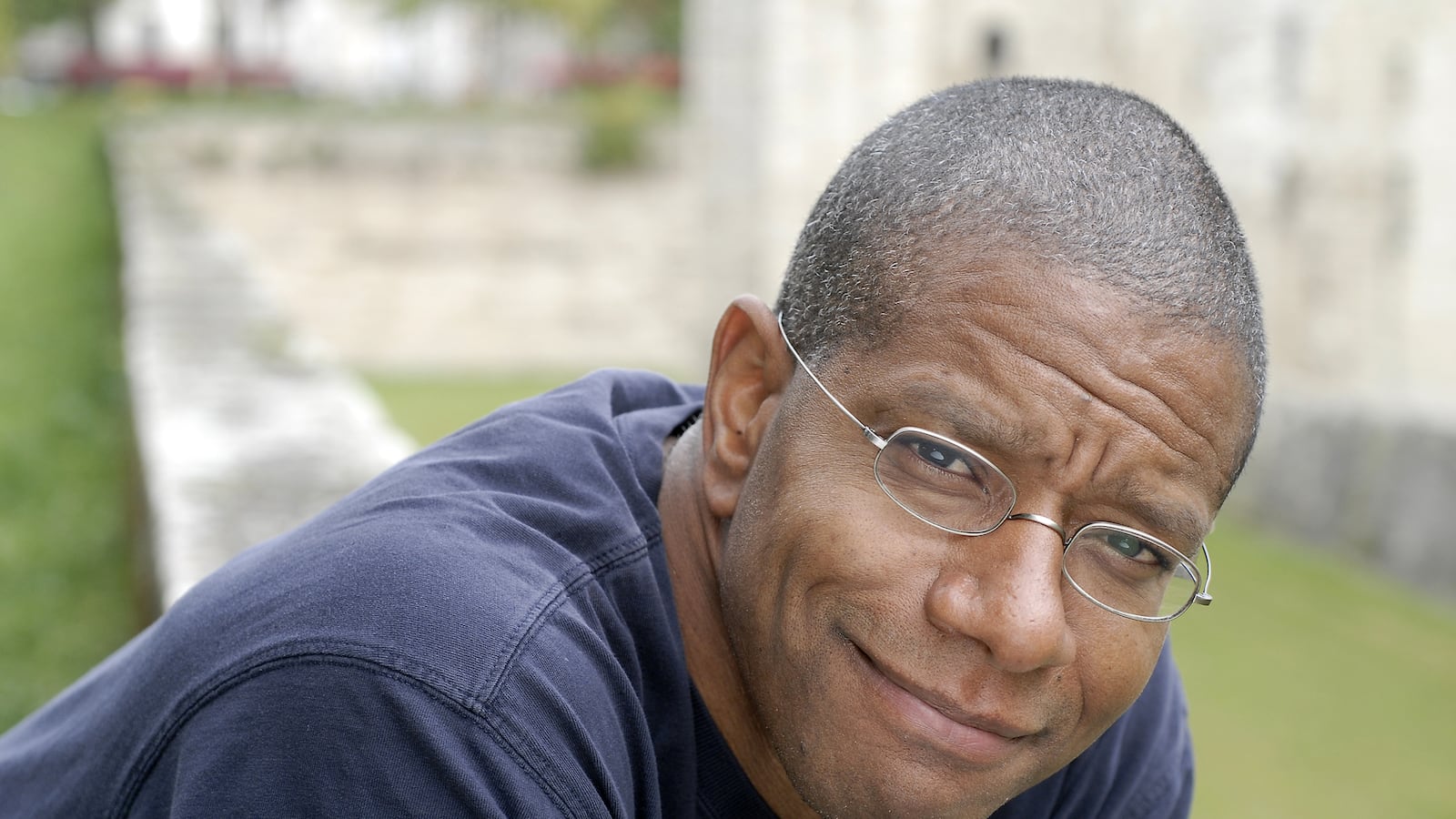Editors' Note: On October 25, Paul Beatty became the first American author to win the presitigious 2016 Man Booker prize for fiction.
2015: the year that the charade of a Post-Racial America was swept finally into history’s dustbin. There it joined Beacon-of-Hope America, Affluent-Society America, and Post-Historical America, fantasies that did not reflect real circumstances so much as the national predilection for wishful thinking. In 2015, Post-Racial America was buried beneath a compost heap of white-on-black police executions, desperate efforts to preserve Confederate symbols in places of public reverence, and the screeds of an orange billionaire openly inciting his white followers to violence against black, brown, beige, and olive semi- and non-citizens. “We are not cured” of racism, Barack Obama said this year, not long after the shooting of nine people at the Emanuel A.M.E. Church in Charleston by a young white supremacist. “Societies don’t overnight completely erase everything that happened 200-300 years prior.”
What happened 200-300 years prior is revived in brazen detail by Paul Beatty in The Sellout, the most perverse novel about race yet published in Obama’s America. To save Dickens, a declining agricultural city on the outskirts of Los Angeles, Beatty’s narrator, a local black farmer named “Bonbon” Me, happens upon an unusual remedy: slavery. Me enslaves his neighbor Hominy Jenkins, the last surviving member of the Little Rascals, at Jenkins’s request. Despondent and beaten down by a lifetime of humiliating roles in Hollywood—Stable Boy, Paper Boy, Shoeshine Boy, Errand Boy—Jenkins yearns “to feel relevant” again. “Sometimes we just have to accept who we are and act accordingly,” he says. “I’m a slave. That’s who I am. It’s the role I was born to play. A slave who just also happens to be an actor.” Jenkins proceeds to address Me as “Massa,” demands to be lashed by whips, and begins “donning a shiny pair of emerald green and pink silks, holding a gas lamp at arm’s length, and posing in my front yard as a life-size lawn jockey.”
Beatty’s characters do more than acknowledge their racism—our racism. They revel in it. Racism becomes a path to honesty, even self-knowledge. It’s an improvement on the current status quo, at least, better than the denial of the racism that pervades our culture and our institutions. The Sellout tries to make sense of a time in which acts of racism are not as taboo as the acknowledgement that no Americans are actually colorblind. A strange and terrible thing happens to both Hominy and Me when they re-enact slavery. They start to feel free.
Me grows more ambitious, posting “priority seating for whites” signs on the town’s public buses, “no whites allowed” or “colored only” signs in storefront windows, a “white and non-talkers only” sign on the floor level of a movie theater and, in the balcony, “blacks, latinos, and the hearing impaired.” The business owners of Dickens are grateful for the signs. “The customers love it. It’s like they belong to a private club that’s public!” When Me puts up a fake construction site for a new whites-only school, test scores at the local public school go up. Passengers on the segregated bus start treating each other with respect.

“People grouse at first,” says one character, “but the racism takes them back. Makes them humble. Makes them realize how far we’ve come and, more important, how far we have to go. On that bus it’s like the specter of segregation has brought Dickens together.”
Beatty, like his narrator, manages to discriminate against every race at the same time. Each ethnic and identity group is held up to ridicule, the stereotypes taken to absurdist extremes. Some of the gentler (printable) examples include a classification of whiteness in America, ranging from Regular (“Benefit of the Doubt,” “Higher Life Expectancy”) to Super Deluxe (“Military Service is For Suckers,” “All Vices and Bad Habits Referred to as ‘Phases’”); a scene at the Supreme Court in which Judge Sotomayor utters Spanish profanities under her breath and Clarence Thomas’s robe is stained with barbecue sauce; and a social justice organization called “The L.A. LGBTDL Crisis Center for Chicanos, Blacks, Non-Gays, and Anyone Else Who Feels Underserved, Unsupported, and Exploited by Hit Cable Television Shows.” But Beatty directs his most biting satire at liberal intellectuals who boast of racial progress and bristle at politically incorrect language.
“What does that mean, I’m offended?” asks Me. “It’s not even an emotion. What does being offended say about how you feel? ... if I ever were to be offended, I wouldn’t know what to do. If I’m sad, I cry. If I’m happy, I laugh. If I’m offended, what do I do, state in a clear and sober voice that I’m offended, then walk away in a huff so that I can write a letter to the mayor?”
Beatty’s prose is amphetaminized and deranged, though never fully able to suppress an undertow of profound pain. “I’ve whispered ‘Racism’ in a post-racial world,” says Me, and he is punished for it, dragged to the nation’s capitol to defend himself before the nation’s highest court. But he doesn’t regret anything. By mocking his own powerlessness, Me empowers himself. He saves Dickens. He restores his pride. He wins the girl. He finds comfort in despair. “Sometimes,” he says, “it’s the nihilism that makes life worth living.”
There is humor to be found in seeing things as they are but there is also wisdom and relief. Beatty’s writing has the unconstrained exuberance available only to a writer who has cast off sobriety, caution, and the dictums of good taste—and possesses a pitch-perfect comic sense. He has accomplished something fleetingly rare in contemporary American literature: he has made his readers uncomfortable. Reviewers everywhere have hailed The Sellout as a comic masterpiece. Many of the novel’s best jokes are racist jokes. Does that mean that readers who find the novel funny are racists? The answer would seem to be yes, which is why everyone who reads The Sellout can’t help but laugh.
Other notable novels published in 2015:
The Water Knife by Paolo Bacigalupi
A Cure for Suicide by Jesse Ball
The Clasp by Sloane Crosley
Purity by Jonathan Franzen
Fates and Furies by Lauren Groff
Delicious Foods by James Hannaham
Welcome to Braggsville by T. Geronimo Johnson
The Beautiful Bureaucrat by Helen Phillips
Pulitzer Prize:
All the Light We Cannot See by Anthony Doerr
National Book Award:
Fortune Smiles: Stories by Adam Johnson
Bestselling novel of the year:
Go Set a Watchman by Harper Lee
About this series:
This monthly series will chronicle the history of the American century as seen through the eyes of its novelists. The goal is to create a literary anatomy of the last century—or, to be precise, from 1900 to 2020. In each column I’ll write about a single novel and the year it was published. The novel may not be the bestselling book of the year, the most praised, or the most highly awarded—though awards do have a way of fixing an age’s conventional wisdom in aspic. The idea is to choose a novel that, looking back from a safe distance, seems most accurately, and eloquently, to speak for the time in which it was written. Other than that there are few rules. I won’t pick any stinkers. — Nathaniel Rich
Previous Selections
1902—Brewster’s Millions by George Barr McCutcheon 1912—The Autobiography of an Ex-Coloured Man by James Weldon Johnson 1922—Babbitt by Sinclair Lewis 1932—Tobacco Road by Erskine Caldwell 1942—A Time to Be Born by Dawn Powell 1952—Invisible Man by Ralph Ellison 1962—One Flew Over the Cuckoo’s Nest by Ken Kesey 1972—The Stepford Wives by Ira Levin 1982—The Mosquito Coast by Paul Theroux 1992—Clockers by Richard Price 2002—Middlesex by Jeffrey Eugenides 2012—Billy Lynn’s Long Halftime Walk by Ben Fountain 1903—The Call of the Wild by Jack London 1913—O Pioneers! By Willa Cather 1923—Black Oxen by Gertrude Atherton 1933—Miss Lonelyhearts by Nathanael West 1943—Two Serious Ladies by Jane Bowles 1953—Junky by William S. Burroughs 1963—The Group by Mary McCarthy 1973—The Princess Bride by William Goldman 1983—Meditations in Green by Stephen Wright 1993—The Road to Wellville by T.C. Boyle 2003—The Known World by Edward P. Jones 2013—Equilateral by Ken Kalfus 1904—The Golden Bowl by Henry James 1914—Penrod by Booth Tarkington 1924—So Big by Edna Ferber 1934—Appointment in Samarra by John O’Hara 1944—Strange Fruit by Lillian Smith 1954—The Bad Seed by William March 1964—Herzog by Saul Bellow1974—Zen and the Art of Motorcycle Maintenance by Robert Pirsig1984—Neuromancer by William Gibson1994—The Stone Diaries by Carol Shields2004—The Plot Against America by Philip Roth2014—The Book of Unknown Americans by Cristina Henríquez
1905—The House of Mirth by Edith Wharton1915—Herland by Charlotte Perkins Gilman1925—Gentlemen Prefer Blondes by Anita Loos1935—Pylon by William Faulkner1945—If He Hollers Let Him Go by Chester Himes1955—Lolita by Vladimir Nabokov1965—The Three Stigmata of Palmer Eldritch by Philip K. Dick1975—The Monkey Wrench Gang by Edward Abbey1985—White Noise by Don DeLillo1995—Independence Day by Richard Ford2005—Veronica by Richard Ford






